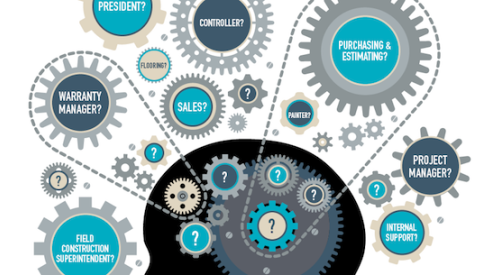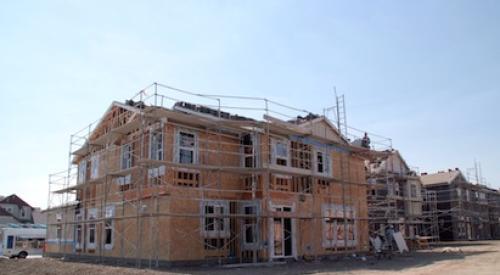|
Contact Scott Sedam
via e-mail at scott@TRUEN.com
|
We recently began a project with a builder I have known for some time. Tom wanted to launch a quality journey, and he expressed a sincere desire to make a break from "standard industry practices."
I start to get enthused when I hear someone speak of wanting to do things right, but I've also learned to be skeptical. So many executives back off when they discover getting there will take time, money or - the hardest thing of all - changing the way they think.
As we got deeper into Tom's philosophy and what he considered wrong with the current wisdom, he began reminiscing about the guy who taught him the trade years ago. He chuckled and shook his head as he recalled his mentor saying over and over again,
"Build 'em up, fix 'em up!
"Build 'em up, fix 'em up!"
That was how it was done back then, yet according to Tom, he and most of his fellow builders in town still do it the same way: Get the houses up and get the buyers closed. Worry about finishing the details later.
This response, of course, begs a lot of questions. So I asked Tom, "If it is true that most companies are building the same way with the same philosophy, why do most builders claim they have improved customer satisfaction?" Incidentally, this claim seems to be confirmed by the upward pattern of J.D. Power scores all across the country.
Tom's chuckle turned into a laugh: "That's simple! We're still doing the same old build 'em up - fix 'em up routine, but now when customers get really mad at us, we give 'em a puppy!"
A puppy? "Ohhhh-kaaaaay ...," I said slowly, in the manner of my 14-year-old son Dylan. My look of confusion brought a quick response from Tom. He described how no one, no matter how upset he or she is with you, can possibly stay mad if you stick a 3-month-old golden retriever in his arms. (Could you?)
Tom went on to describe how the "puppy" might also take the form of a fruit basket, a microwave, or a huge dose of personal attention from your most skilled employee. But in some way, Tom explained, "We give 'em a puppy." He guessed that J.D. Power and Associates had been really good for the puppy business.
I can now die a happy man, I thought. I have found the secret. I pointed out to Tom that if you combine his mentor's philosophy with this new revelation, you have in one short phrase a perfect description of how to succeed in homebuilding:
Build 'em up ...
Fix 'em up ...
Give 'em a puppy!
You gotta love that - except for one small problem. It hurts. It hurts because it's still so true. Only a small portion of the home building industry's progress in recent years is due to genuine improvements in process, product or people. Most of it is the result of some form of throwing time and money at the back end of the building process or, even worse, after the customer has moved in. And we have done it - and it has worked - because for the past dozen or so years, we have been able to afford it.
Profit margins have nearly doubled in that decade-plus for public and private builders alike. Unfortunately, very little has been due to savings in costs or time. Most of the gain has come from continued demographic-driven demand and low interest rates. This combination has allowed us to raise prices almost continually. The pricing in some markets - as diverse and far-flung as Fairfax and Fresno - can be described as nothing other than "irrational." Perhaps Alan Greenspan was right.
Maybe you think I'm being a little hard, so here's a challenge for you. Spend a week working side by side with your field superintendents. See what they do all day, every day.
Recently, I found an old overhead slide (yes, one of those plastic things with black lettering burned onto it) from a 1989 presentation in which I described the then-current state of the industry with the term, "Brute Force Quality." In the notes on the white cardboard frame around the slide, I had penciled, "We deliver (eventually) a quality house. But the costs to get there are astounding!" The next printed words on the slide were the definition of Brute Force Quality:
Constant Supervision.
Mass Inspection.
Continual Rework.
Be honest. Is this your M.O.? I constantly hear about it in my travels. Not long ago, I received an e-mail from a customer service manager working for a builder who is recognized nationwide as one of the best in the country - name withheld to protect the guilty, of course. This manager had just finished placing 450 paint dots to mark defects in a home that was submitted as ready to close - in three days. She was absolutely fried and had some choice things to say about how her company did quality. I see builders who keep throwing money at their warranty programs, otherwise known as: "Fix it after it's broke and while the customer can watch you." How completely insane is that?
So let's make a few things perfectly clear. First of all, you all deliver a 100 percent complete home to the customer eventually, don't you? It may be a month after closing, three months, six months - but it does get finished. And just how much more does it cost to do that after a customer moves in? I will suggest to you at least eight areas of cost:
1. Raw dollar costs from excess service personnel, chargebacks, and the management and administration of the service system.
2. Costs to your trades who get involved and who rarely bill you directly. But you know that somehow, somewhere, those costs are going to be borne by you and your customers.
3. Costs to your customers in time and aggravation, providing them inspiration to find ways of getting even.
4. Costs to your employees in time and frustration. No one likes dealing with angry customers.
5. Costs to your schedule, as the trades that do service chores cannot be working on homes in the regular production cycle.
6. Costs to your credibility inside: These costs only get worse each time you repeat the mantra to the troops about "building it right the first time" and "closing no home until it's ready."
7. Cost to your reputation outside, as customers pass on their tales of unfinished homes to others in the community.
8. The cost of "puppies": reparations in some form or another, designed to get back into the customers' good graces.
So please explain this to me: If you get every last home done eventually - with all of these costs - why in the world don't you just do it before closing? It is so much easier. So much faster. So much cheaper. There are enough builders actually doing this now, so no one can say it can't be done. The traditional excuses and explanations just don't stand up to scrutiny.
But let's say you are among the minority that fully grasps the implications of closing unfinished homes. You bust your tail to get these things right before closing, so you've now solved the problem, right? Most likely not. What you have done is shifted the rework phase to the two or three weeks just before closing.
I will absolutely grant you: "Before" is better than "after" closing, but you still have not escaped the Brute Force Quality trap. The costs of supervision, inspection and rework are huge. We are stilled so mired in getting the homes banged out, we don't really think about prevention.
What's going to happen when this market finally does peak and slow down? I'm certainly not wishing for it or predicting it. Enough people have sounded foolish doing that the past seven years. But when money once again gets tight, how will we deliver the quality? How will we afford the rework? How will we afford the puppies?
We'd better learn to build 'em up right the first time and skip the "fix 'em up." Right now, most of us are simply buying our way to improved quality and improved customer-satisfaction scores. The time is coming when we'll have to learn what other industries, such as automotive and electronics, learned before us. We will have to learn prevention.
There just aren't enough puppies to go around.












